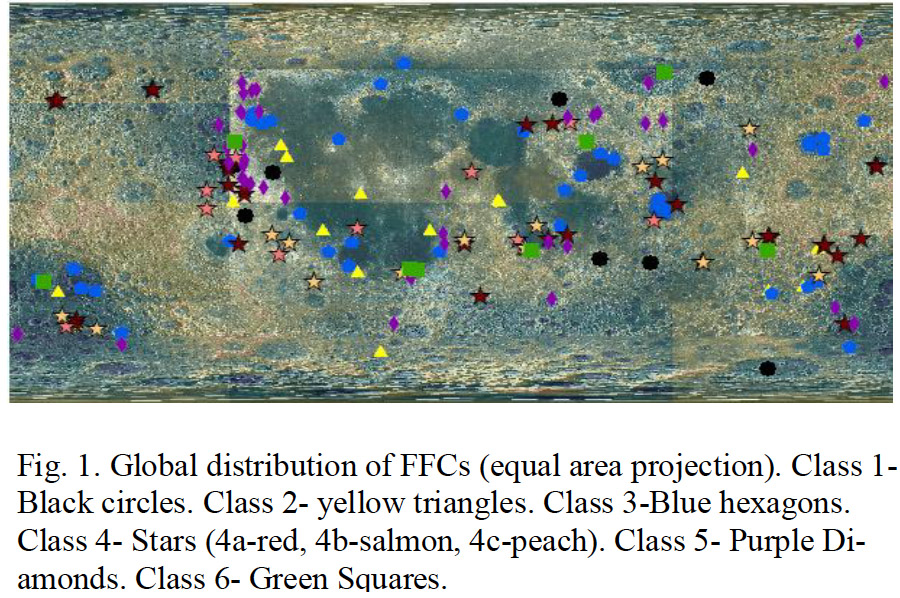Floor Fractured Craters
Contents
Floor Fractured Craters
(glossary entry - adapted from Chuck Wood's Moon web site - see illustrations there)
Image from Jozwiak, L.M. and others (2012)
Description
The majority of lunar craters are small and simple impact craters. But for some craters larger than 20-30 km the impact morphology is modified by volcanic-related activity. Posidonius is an excellent example and it and similar craters share many of these characteristics: shallow, mare-flooded floor, concentric and radial rilles, dark halo craters, and location near a mare. In 1976 Peter H. Schultz recognized these commonalities and named such craters Floor Fractured Craters (FFC).
Additional Information
Schultz detected 206 FFC and proposed that they formed by magma which rose up basin fractures and ponded under the crater floor. The pressure of the magma lifted the crater floor (accounting for FFC shallowness) and produced the fractures. In many FFC craters, lava escaped to the surface, creating lava ponds, sinuous rilles and dark halo craters. Because of such volcanic modifications, FFC are among the most interesting craters on the Moon for observers.
Schultz classified FFC into 6 types based on their crater depth, fracture pattern and floor type. On the right above is Schultz' illustration showing examples of each FFC class, and below is a summary of class characteristics:
- Class I: Fractured-floor impact craters. Have most characteristics of fresh large impact crater (central peaks, wall terraces or slumps and ejecta blanket) but also floor fractures (rilles), mare patches and dark halo craters. Examples are Atlas, Petavius and Humboldt.
- Class II: Shallow, with fractured hummocky (hilly) floor. Smaller craters than Class I with sharp wall scarp and shallow, hummocky floor cut by concentric rilles. Examples include Encke and Vitello.
- Class III: Wide moat floor. A wide annular moat filled with mare or light-hued plains separates the inner floor from the crater wall. Examples are Gassendi, Posidonius and Warner.
- Class IV: Narrow moat floor. Overall smaller craters than Class III, lacking terraces. Floor looks like domed loaf of bread with ridged radial fractures. Illustration above includes two sub-types. IV A & B. of this type of FFC. Examples include Gaudibert and Bohnenberger.
- Class V: Fractured light plains. Appear to be older large craters that are little modified except for smooth floors (typically light-hued) cut by linear rilles. Some may have dark halo craters. Examples are Alphonsus and Von Braun.
- Class VI: Fractured mare floor. Broad, shallow mare flooded craters with fractures/rilles. Examples are Pitatus and Tsiolkovskiy.
As you observe the Moon and look at images you may notice other FFC craters and you should consider which of these classes they fit into.
Schultz's map of FFC distribution shows that they are mostly near mare regions and that many occur in clusters. There's even a tendency of "binary" appearances of FFCs, as recently noticed by Danny Caes on the WAC mosaic of the LROC's online ACT-REACT Quick Map.
FFC List
Schultz has not published his extensive list of FFC but here is a short compilation and an additional (experimental) new list to guide your studies of these fascinating craters. Note that some of these FFC are relatively small (40 km is small when you are trying to see details on the floor) or close to the limb so that observing floor features will be difficult.
LPOD Articles
Bibliography
- Schultz, P. H. 1976. Floor-fractured lunar craters. The Moon. vol. 15, pp. 241-273.
- Hall, J. L.; Solomon, S. C.; Head, J. W. 1981. Lunar Floor-Fractured Craters: Evidence for Viscous Relaxation of Crater Topography. Lunar And Planetary Science XII, pp. 389-391.
- Wichman, R. W.; Schultz, P. H. 1995. Floor-fractured craters in Mare Smythii and west of Oceanus Procellarum: Implications of Crater Modification by Viscous Relaxation and Igneous Intrusion Models. Journal of Geophysical Research, Volume 100, Issue E10, p. 21201-21218
- Dombard, Andrew J.; Gillis, Jeffery J. 2001. Testing the viability of topographic relaxation as a mechanism for the formation of lunar floor-fractured craters. Journal of Geophysical Research, Volume 106, Issue E11, p. 27901-27910
- Jozwiak, L.M. and others (2012) Lunar Floor-Fractured Craters: Classification, Distribution, and Implications for Magmatism and Shallow Crustal Structure. 43rd LPSC #1512.
- Guest, J. E. / Greeley, R. Geologie auf dem Mond (Ferdinand Enke Verlag Stuttgart 1979), page 178: Krater mit zerbrochenen boden.